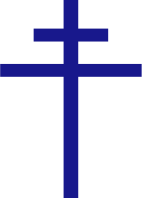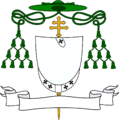- Patriarchal cross
-
The Patriarchal cross is a variant of the Christian cross, the religious symbol of Christianity. Similar to the familiar Latin cross, the Patriarchal cross possesses a smaller crossbar placed above the main one, so that both crossbars are near the top. Sometimes the patriarchal cross has a short, slanted crosspiece near its foot. This slanted, lower crosspiece often appears in Byzantine Greek and Eastern European iconography, as well as Eastern Orthodox churches.
The symbol, often referred to as the patriarchal cross, appeared in the Byzantine Empire in large numbers in the 10th century. In the Byzantine Empire of the 10th century, the double cross was not a religious, but a political symbol used by Byzantine clerks and missionaries.[citation needed]
For a long time, it was thought to have been given to Saint Stephen by the pope as the symbol of the apostolic Kingdom of Hungary. The two-barred cross is one of the main elements in the Hungarian coats of arms since 1190, it appeared during the reign of King Béla III, who was raised in the Byzantine court. The cross appears floating in the coat of arms and on the coins from this era.
The direct predecessor of the current coat of arms of Slovakia can be found in the coat of arms used by Béla III. Another interpretation says that the slovakian coat of arms represents Slovakia's past link with Hungary and it is a modified version of the Hungarian coat of arms.The two-barred cross in the Hungarian coat of arms originated in the Byzantine (Eastern Roman) Empire in the 9th century. Unlike the Christian cross, the symbolism and meaning of the double cross is not well understood. One interpretation is that the first horizontal line symbolized the secular power and the other horizontal line the ecclesiastic power of Byzantine emperors. Another that the first cross represents the death and the second cross the resurrection of Jesus Christ. In the Byzantine Empire of the 9th century, the double cross was a political symbol used by Byzantine clerks and missionaries.[citation needed]
Another theory (by slovakian historians) says that the double cross arrived to the part of the Hungarian Kingdom (current-day Slovakia) during the 9th century mission of Cyril and Methodius to Great Moravia.[citation needed] Though used frequently in Great Moravia, it was not a state symbol at that time, because there were no state symbols in the modern sense in Europe at that time yet. By means of Zwentibold (the ruler of Lorraine, son of the German emperor Arnulf of Carinthia and godchild of the Great Moravian king Svatopluk I), this symbol got to Lorraine and is called the cross of Lorraine there.[citation needed]
Contents
Imagery
 A three-bar cross (black) inside a cross bottony (the letters are the Greek abbreviation for "Jesus Christ" - ΙΗΣΟΥΣ ΧΡΙΣΤΟΣ Iesous Christos).
A three-bar cross (black) inside a cross bottony (the letters are the Greek abbreviation for "Jesus Christ" - ΙΗΣΟΥΣ ΧΡΙΣΤΟΣ Iesous Christos).
The top beam represents the plaque bearing the inscription "Jesus of Nazareth, King of the Jews" (often abbreviated in the Latinate "INRI", and in the Greek as "INBI"). A popular view is that the slanted bottom beam is a foot rest, however there is no evidence of foot rests ever being used during crucifixion, and it has a deeper meaning. The bottom beam may represent a balance of justice. Some sources suggest that, as one of the thieves being crucified with Jesus repented of his sin and believed in Jesus as the Messiah and was thus with Christ in Paradise, the other thief rejected and mocked Jesus and therefore descended into Hades.
Many symbolic interpretations of the double cross have been put forth. One of them says that the first horizontal line symbolized the secular power and the other horizontal line the ecclesiastic power of Byzantine emperors.[citation needed] Also, that the first cross bar represents the death and the second cross the resurrection of Jesus Christ.
Other variations
The Russian Orthodox cross can be considered a modified version of the Patriarchal cross, having two smaller crossbeams, one at the top and one near the bottom, in addition to the longer crossbeam. One suggestion is the lower crossbeam represents the footrest (suppendaneum) to which the feet of Jesus were nailed. In some earlier representations (and still currently in the Greek Church) the crossbar near the bottom is straight, or slanted upwards. In later Russian and other traditions, it came to be depicted as slanted, with the side to the viewer's left usually being higher. During 1577–1625 the Russian cross was between the heads of the double-headed eagle in the coat of arms of Russia.
One tradition says that this comes from the idea that as Jesus Christ took his last breath, the bar to which his feet were nailed broke, thus slanting to the side. Another tradition holds that the slanted bar represents the repentant thief and the unrepentant thief that were crucified with Christ, the one to Jesus' right hand repenting and rising to be with God in Paradise, and one on his left falling to Hades and separation from God. In this manner it also reminds the viewer of the Last Judgment.
Still another explanation of the slanted crossbar would suggest the Cross Saltire, as tradition holds that the Apostle St. Andrew introduced Christianity to lands north and west of the Black Sea: today's Ukraine, Russia, Belarus, Moldova, and Romania.
-
Roman Catholic metropolitan archbishop's coat of arms (version with pallium
-
Saint Stephen, the first King of Hungary (1000–1038). The most ancient element of the Coat of arms of Hungary is the double cross.
-
Serbian Tsar Stefan Dušan holding the patriarchal cross.
-
A variation of the Russian cross, so called "Calvary cross"
--绿叶子 (talk) 13:55, 15 October 2011 (UTC)
Typefaces
Unicode defines the character ☦ (ORTHODOX CROSS) in the Miscellaneous Symbols range at codepoint U+2626.
See also
- Papal cross
- Two-barred cross
- Cross of Lorraine
- Coat of Arms of Hungary (since 1190)
- Coat of Arms of Slovakia
- Pahonia (historical symbol of Belarus)
Categories:- Eastern Orthodoxy
- Christian symbols
- Cross symbols
- National symbols of Belarus
-
Wikimedia Foundation. 2010.






